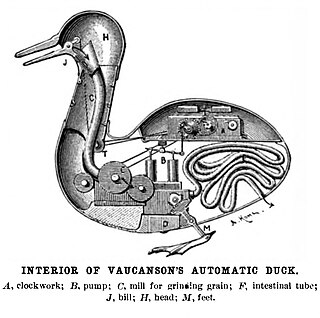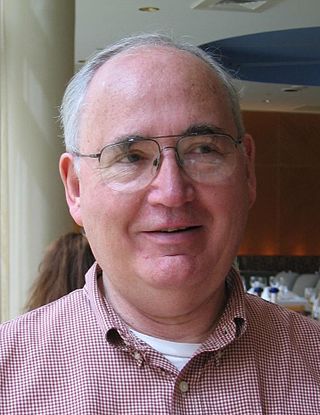Related Research Articles

Category theory is a general theory of mathematical structures and their relations. It was introduced by Samuel Eilenberg and Saunders Mac Lane in the middle of the 20th century in their foundational work on algebraic topology. Category theory is used in almost all areas of mathematics. In particular, many constructions of new mathematical objects from previous ones that appear similarly in several contexts are conveniently expressed and unified in terms of categories. Examples include quotient spaces, direct products, completion, and duality.
In the philosophy of mathematics, intuitionism, or neointuitionism, is an approach where mathematics is considered to be purely the result of the constructive mental activity of humans rather than the discovery of fundamental principles claimed to exist in an objective reality. That is, logic and mathematics are not considered analytic activities wherein deep properties of objective reality are revealed and applied, but are instead considered the application of internally consistent methods used to realize more complex mental constructs, regardless of their possible independent existence in an objective reality.
Mathematical logic is the study of formal logic within mathematics. Major subareas include model theory, proof theory, set theory, and recursion theory. Research in mathematical logic commonly addresses the mathematical properties of formal systems of logic such as their expressive or deductive power. However, it can also include uses of logic to characterize correct mathematical reasoning or to establish foundations of mathematics.
In the philosophy of mathematics, constructivism asserts that it is necessary to find a specific example of a mathematical object in order to prove that an example exists. Contrastingly, in classical mathematics, one can prove the existence of a mathematical object without "finding" that object explicitly, by assuming its non-existence and then deriving a contradiction from that assumption. Such a proof by contradiction might be called non-constructive, and a constructivist might reject it. The constructive viewpoint involves a verificational interpretation of the existential quantifier, which is at odds with its classical interpretation.

Set theory is the branch of mathematical logic that studies sets, which can be informally described as collections of objects. Although objects of any kind can be collected into a set, set theory — as a branch of mathematics — is mostly concerned with those that are relevant to mathematics as a whole.

Willard Van Orman Quine was an American philosopher and logician in the analytic tradition, recognized as "one of the most influential philosophers of the twentieth century". He served as the Edgar Pierce Chair of Philosophy at Harvard University from 1956 to 1978.
In mathematics and theoretical computer science, a type theory is the formal presentation of a specific type system. Type theory is the academic study of type systems.
Philosophy of mathematics is the branch of philosophy that deals with the nature of mathematics and its relationship with other human activities.

Reductionism is any of several related philosophical ideas regarding the associations between phenomena which can be described in terms of other simpler or more fundamental phenomena. It is also described as an intellectual and philosophical position that interprets a complex system as the sum of its parts.

Cantor's diagonal argument is a mathematical proof that there are infinite sets which cannot be put into one-to-one correspondence with the infinite set of natural numbers – informally, that there are sets which in some sense contain more elements than there are positive integers. Such sets are now called uncountable sets, and the size of infinite sets is treated by the theory of cardinal numbers, which Cantor began.
In the philosophy of mathematics, ultrafinitism is a form of finitism and intuitionism. There are various philosophies of mathematics that are called ultrafinitism. A major identifying property common among most of these philosophies is their objections to totality of number theoretic functions like exponentiation over natural numbers.

Dana Stewart Scott is an American logician who is the emeritus Hillman University Professor of Computer Science, Philosophy, and Mathematical Logic at Carnegie Mellon University; he is now retired and lives in Berkeley, California. His work on automata theory earned him the Turing Award in 1976, while his collaborative work with Christopher Strachey in the 1970s laid the foundations of modern approaches to the semantics of programming languages. He has also worked on modal logic, topology, and category theory.
Proof theory is a major branch of mathematical logic and theoretical computer science within which proofs are treated as formal mathematical objects, facilitating their analysis by mathematical techniques. Proofs are typically presented as inductively-defined data structures such as lists, boxed lists, or trees, which are constructed according to the axioms and rules of inference of a given logical system. Consequently, proof theory is syntactic in nature, in contrast to model theory, which is semantic in nature.
Hume's principle or HP says that the number of Fs is equal to the number of Gs if and only if there is a one-to-one correspondence between the Fs and the Gs. HP can be stated formally in systems of second-order logic. Hume's principle is named for the Scottish philosopher David Hume and was coined by George Boolos.
In mathematics, a constructive proof is a method of proof that demonstrates the existence of a mathematical object by creating or providing a method for creating the object. This is in contrast to a non-constructive proof, which proves the existence of a particular kind of object without providing an example. For avoiding confusion with the stronger concept that follows, such a constructive proof is sometimes called an effective proof.
In mathematics, a set is inhabited if there exists an element .
In mathematical physics, Gleason's theorem shows that the rule one uses to calculate probabilities in quantum physics, the Born rule, can be derived from the usual mathematical representation of measurements in quantum physics together with the assumption of non-contextuality. Andrew M. Gleason first proved the theorem in 1957, answering a question posed by George W. Mackey, an accomplishment that was historically significant for the role it played in showing that wide classes of hidden-variable theories are inconsistent with quantum physics. Multiple variations have been proven in the years since. Gleason's theorem is of particular importance for the field of quantum logic and its attempt to find a minimal set of mathematical axioms for quantum theory.
Philosophy of logic is the area of philosophy that studies the scope and nature of logic. It investigates the philosophical problems raised by logic, such as the presuppositions often implicitly at work in theories of logic and in their application. This involves questions about how logic is to be defined and how different logical systems are connected to each other. It includes the study of the nature of the fundamental concepts used by logic and the relation of logic to other disciplines. According to a common characterisation, philosophical logic is the part of the philosophy of logic that studies the application of logical methods to philosophical problems, often in the form of extended logical systems like modal logic. But other theorists draw the distinction between the philosophy of logic and philosophical logic differently or not at all. Metalogic is closely related to the philosophy of logic as the discipline investigating the properties of formal logical systems, like consistency and completeness.

In mathematical logic and computer science, homotopy type theory (HoTT) refers to various lines of development of intuitionistic type theory, based on the interpretation of types as objects to which the intuition of (abstract) homotopy theory applies.

Logic is the study of correct reasoning. It includes both formal and informal logic. Formal logic is the study of deductively valid inferences or logical truths. It examines how conclusions follow from premises due to the structure of arguments alone, independent of their topic and content. Informal logic is associated with informal fallacies, critical thinking, and argumentation theory. It examines arguments expressed in natural language while formal logic uses formal language. When used as a countable noun, the term "a logic" refers to a logical formal system that articulates a proof system. Logic plays a central role in many fields, such as philosophy, mathematics, computer science, and linguistics.
References
- 1 2 Mandelkern 1989, p. 3.
- ↑ Ball 1889, p. 45.
- ↑ Hofmann 2003.
- ↑ Griffiths & Hilton 2013.
- ↑ Chan 2023, p. 341.
- ↑ Bridges & Richman 1987, Preface.
- ↑ Blackburn 2016, mathematical logic.
- ↑ Ferreirós 2010.
- ↑ Stewart Shapiro, ed. (2005). The Oxford Handbook of Philosophy of Mathematics and Logic. Oxford University Press, USA. ISBN 978-0-19-514877-0.
- ↑ Torkel Franzén (1987). Provability and Truth. Almqvist & Wiksell International. ISBN 91-22-01158-7.